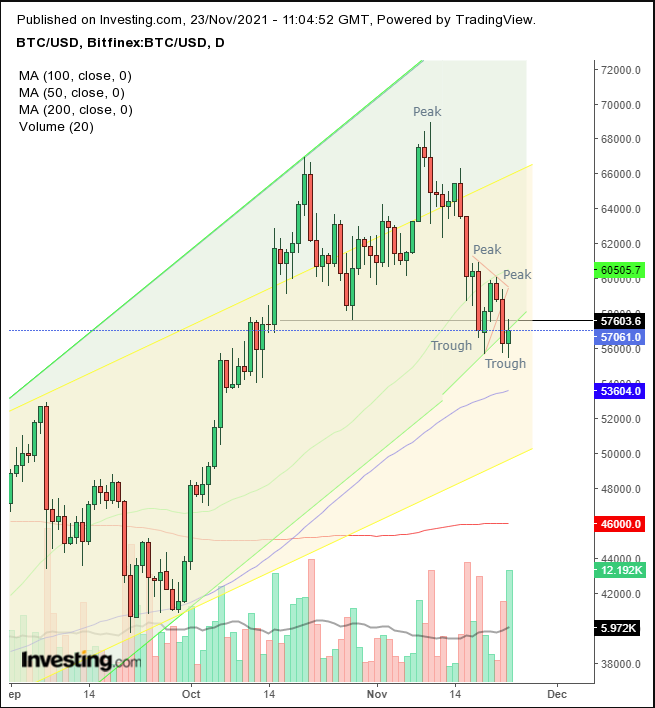Bitcoin is on course for its worst back-to-back weekly selloff since it topped out in mid May from then record high levels. The largest cryptocurrency by market cap is currently trading above the day's lows—which were below $56K—distancing its price nearly 20% from its Nov. 10 all-time high, above $68,000. It could also be heading for its lowest levels since Oct. 20.
After a prolonged rally on expectations, investors are now selling off the token after reports last week indicated that "creditors of collapsed crypto exchange Mt Gox might liquidate their payments."
Could today's uptick indicate the selloff might be over, providing a buying dip? We think not based on technical indicators.

BTC is rebounding today after it may have completed a pennant, bearish after the preceding near 16% drop within just five sessions.
The pennant may not satisfy purist technicians though. They might demand at least two touches on the bottom of the presumed pattern. Whether the trading between Nov. 17 and 21, which meets the minimum 5-day requirement, merits the pennant designation or not, we think the price action will carry a similar dynamic.
First, remember that Bitcoin is not a traditional asset. As such it requires rules of its own. Though there's no accepted textbook on the crypto asset class as yet, experience watching volatile Bitcoin trading has allowed us to form an opinion regarding the trading psychology in play for this non-traditional asset.
So here's the evidence supporting our pennant thesis in recent trading:
- A pennant requires a preceding sharp move, almost in a straight line. Nearly 16% in only five sessions satisfies that requirement.
- The preceding volume was high, while the volume amid trading during the range dried out, then finally spiked again upon breakout—that's classic volume behavior for a genuine pennant.
- The pennant developed smack on the level of the previous low at $57,612, registered on Oct. 28. That technical checkpoint creates the condition for a struggle between bulls and bears, which sets up the pennant.
- The pennant developed when the 50 DMA caught up with the price for the first time since crossing above the moving average on Oct. 1.
- Finally, the continuation pattern formed right at the bottom of the rising channel.
The last two points reiterate point number 3—when the asset reaches a price point of contention, it tends to then range, an interruption in the underlying trend. Given that the pennant's nature is as a continuation pattern, we expect the breakout to be the same direction as its preceding trend. As we've said, we believe that might have already happened in Monday's trading.
Still, even if another leg lower follows through, it will be considered temporary at this point. The descending peak and trough formation is for the short-term. On the weekly chart, the uptrend remains obviously higher.
Let's now measure the move before the pennant, since it's expected to repeat on the other side. From the top of the activity on Nov. 15 to the bottom of the move on Nov. 19 is a $10,650 'span.' A repeat of that move would take the digital currency to below $48,000.
If momentum were to yank Bitcoin down to that level, the token would also then violate the slower rising channel (yellow). But we're not there yet. Until that level is breached, we expect the rising channel bottom to maintain the uptrend.
Trading Strategies
Conservative traders should not enter a trade that's contrary to the long-term trend.
Moderate traders would wait for the price to close below the faster (green) rising channel and perhaps wait for a price that's closer to the pattern in order to reduce exposure.
Aggressive traders would short at will, provided they can withstand a return to the pennant. Therefore, a coherent trading plan is essential. Here's an example:
Trade Sample
- Entry: $58,000
- Stop-Loss: $60,000
- Risk: $2,000
- Target: $52,000
- Reward: $6,000
- Risk-Reward Ratio: 1:3
